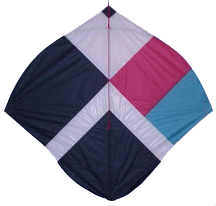Kite Flying Ban in Pakistan
First it was a ban on kite flying in Afghanistan during the period of control by the Taliban from 1994 to 2002. Now there is a ban on kite flying in Pakistan based on a Supreme Court ruling handed down in Lahore, the capital of Pakistan , on Monday, October 24, 2005.
The reasons for the bans in the two countries are very different.
In Afghanistan, Mullah Mohammed Omar and the ruling clerics imposed the ban in 1994 based on a strict interpretation of Sharia Law utlized by the Taliban in governing Afghanistan. The purpose of the ban on kite flying was to eliminate frivolous activities that took the minds of people away from the fundamental Islamic beliefs and codes of conduct being emphasized by the Mullahs at the time. Among some of the other activities banned were gambling, the use of television and use of the Internet.
When the rule of Afghanistan by the Taliban came to an end in 2002, one of the first activities engaged in was the flying of kites. Men and boys raised their kites once again in the traditional flying combat that is at the heart of kite flying in that country and this region of Asia and the Indian sub-continent.
 Kite flying almost always involves a two person team in flying the Afghan fighter kite. One person, the "charka gir," holds the wooden spool around which the line (known as 'wire', or "tar") is wound. The second person -- called the "gudiparan baz," or kite flyer -- actually controls the movement of the kite in the air. During the fight, or "jang," two kites are flown close to one another, often at great heights. The object is to use the wire/line of your kite to cut the wire of your opponent's kite and set it free. Frequently long pieces of cut line or wire are left on the ground, draped over vegetation or across buildings.
Kite flying almost always involves a two person team in flying the Afghan fighter kite. One person, the "charka gir," holds the wooden spool around which the line (known as 'wire', or "tar") is wound. The second person -- called the "gudiparan baz," or kite flyer -- actually controls the movement of the kite in the air. During the fight, or "jang," two kites are flown close to one another, often at great heights. The object is to use the wire/line of your kite to cut the wire of your opponent's kite and set it free. Frequently long pieces of cut line or wire are left on the ground, draped over vegetation or across buildings.
While the ban on kite flying in Afghanistan was for stated religious purposes, the upcoming ban in Pakistan is essentially for safety reasons and to minimize economic loss.
When the Supreme Court of Pakistan announced their ruling banning kite flying during the upcoming Basant festival period from mid-January to mid-February of 2006, there was a body of data that supported the fact that the use of coated or wire kite line is very dangerous to the environment, humans and the power grid.
The types of line used in flying in Pakistan and the region are very different from the synthetic or pure cotton lines used in European and North American kiting. Sometimes known as "manja", the kite line used in Pakistan, India and Afghanistan is strengthened in one of three ways:
- cotton line coated with finely ground powdered glass;
- cotton line with a thin filament of wire twisted into the line;
- cotton line coated with chemical mixes.
All of these methods of strenghtening the line provide the quality necessary for kite battle at long-distance heights. By sharply moving your line across the line of an opponent you have a great chance of cutting his or her line and freeing the kite from the control of your opponent. Then the kite drifts to earth, often trailing considerable lengths of manja.
Therein lies the problem. The fortified line frequently injures people or animals. Sometimes the cuts are serious and on occasion, lives have been lost due to the severity of the cut (e.g. a two year old girl died in Lahore in 2005).
The line also falls on the electrical grid and can create shorts and outages due to the embedded wire filament or when the chemical line gets wet and acts as a conductor. Over 25,000 tripped circuits of major sections of the city grid of Lahore were recorded during the Basant festival of 2005. The Lahore Electric Supply Company (LESCO) estimated that there was damage to the electrical distributions system in the amount of 30 million rupees during 2005. This figure did not take into account the resultant damage to home appliances, industrial machines and computers caused by sudden outages and power surges.
A number of businesses, social and political groups have petitioned for laws and ordinances banning kite flying which does damage to property and people. All of this culminated in the Supreme Court issuing the ruling this week that imposed the ban on kites during the month long Basant (spring festival) celebrations.
 However, kite flying is a strong tradition that is embedded into the national culture in Pakistan, India and Afghanistan. Anyone who has witnessed the passion and wide involvement of the populace in kite flying during the spring in any of these nations has to wonder if a legislated ban will curb the dangerous aspects of the sport.
However, kite flying is a strong tradition that is embedded into the national culture in Pakistan, India and Afghanistan. Anyone who has witnessed the passion and wide involvement of the populace in kite flying during the spring in any of these nations has to wonder if a legislated ban will curb the dangerous aspects of the sport.
In addition, KB Thread, a major manufacturer of cotton thread (which contains fine wire filament) has petitioned the court to permit continued manufacture of the thread which is used in the carpet and garment industries of Pakistan. Many thousands of men and women are employed in these industries. It may turn out that an "unintended consequence" of the ban on kite flying and the production of kite lines will be an economic force to be reckoned with.
My hunch is that come spring in Pakistan, Basant will be celebrated with thousands of kites in the sky once again. Sheer numbers of citizens wanting to fly, compete and celebrate may over power a well intended public safety ruling.





Reader Comments (4)
Great information here, well done!
--Bill
Images of basant makes the future something to look forward to...
1 pic is worth a million words.